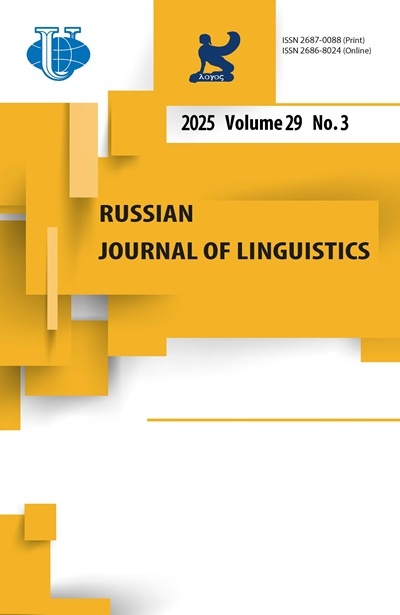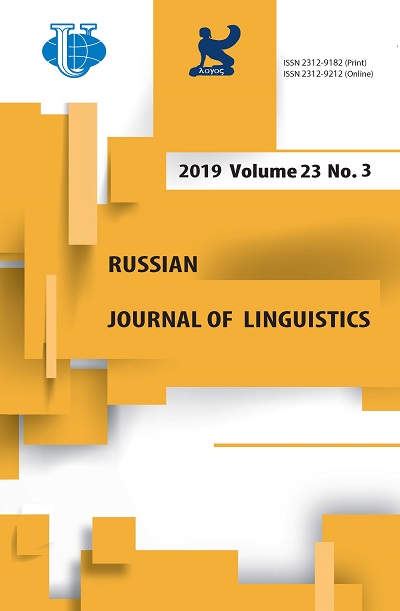Говорить устами Бахтина: две интерпретации косвенной речи (ответ К. Годдарду и А. Вежбицкой [2018])
- Авторы: Спронк С.1
-
Учреждения:
- Хельсинский университет
- Выпуск: Том 23, № 3 (2019)
- Страницы: 603-618
- Раздел: Статьи
- URL: https://journals.rudn.ru/linguistics/article/view/21768
- DOI: https://doi.org/10.22363/2312-9182-2019-23-3-603-618
- ID: 21768
Цитировать
Полный текст
Аннотация
Работа В. Н. Волошинова (Vološinov, 1929/1973) - один из наиболее цитируемых научных трудов, посвященных косвенной речи, однако его интерпретация разными авторами неоднозначна. В рамках лингвоантропологической традиции его основной посыл часто смешивается с «ролями говорящего» Э. Гоффмана, а в своей недавней публикации К. Годдард и А. Вежбицкая (2018) объединяют идеи, которые они приписывают В. Н. Волошинову и М. М. Бахтину, с идеями представителя формальной семантики Д. Дэвидсона. Настоящая статья - это ответ Годдарду и Вежбицкой (2018), в ней рассматриваются философские основы исследования косвенной речи, особенно по отношению к идеям Волошинова / Бахтина. Высказывается мысль о том, что изучение косвенной речи преследует две основные цели, одна из которых восходит к Фреге, а вторая - к Бахтину. Вопросы и методы, связанные с этими традициями, ведут к двум радикально различным пониманиям косвенной речи. Это влияет на применимость определения прямой / непрямой речи, предлагаемого Годдардом и Вежбицкой, а также порождает альтернативный подход, развиваемый автором данной статьи и другими учеными и критикуемый Годдардом и Вежбицкой (Там же). Цель статьи - реабилитировать анализ Вежбицкой (1974), от которого Годдард и Вежбицкая (2018) частично отказываются. Рассматривая прямую и непрямую речь как английские конструкты, они, тем не менее, поднимают это понятие до универсального уровня, что вступает в противоречие с понятием культурной сенситивности относительно семантических вариаций, о котором они пишут в других работах. Автор статьи приходит к выводу, что, в свете современных тенденций описания языка, труд Волошинова (1929/1973) не теряет свой значимости и заслуживает всяческого внимания.
Ключевые слова
Об авторах
Стеф Спронк
Хельсинский университет
Email: stef.spronck@helsinki.fi
получил степень PhD в Австралийском национальном университете (2016), научный сотрудник Хельсинского университета (Финляндия), до этого - Лёвенского универ- ситета (Бельгия). После обучения по программе славянского и общего языкознания в Амстер- дамском университете (Нидерланды) провел обширное полевое исследование языков або- ригенов Австралии, в частности косвенной речи и картины мира аборигенов Ungarinyin. Сфера научных интересов: типология, диалогическая лингвистика, чужая речь. PL 24 (Unioninkatu 40) Хельсинки, 00014, Финляндия
Список литературы
- Abbott, Barbara (2011). Attitudes Toward Quotation. In Understanding Quotation, edited by Elke Brendel, Jörg Meibauer, and Markus Steinbach, 35-46. Berlin/New York: De Gruyter Mouton.
- Bakhtin, Mikhail (1981). The Dialogic Imagination: Four Essays by M. M. Bakhtin. Edited by Michael Holquist. Austin: University of Texas.
- Banfield, Ann (1982). Unspeakable Sentences: Narration and Representation in the Language of Fiction. Boston: Routledge & Kegan Paul.
- Bertau, Marie-Cécile (2004). Reflections on Addressivity: From the Role of the Other to Developmental Aspects. In Aspects of the Dialogical Self: Extended Proceedings of a Symposium on the Second International Conference on the Dialogical Self, edited by Marie-Cécile Bertau, 87-128. Berlin: Lehmanns.
- Bota, Cristian, and Jean-Paul Bronckart (2011). Bakhtine Démasqué: Histoire d’un Menteur, d’une Escroquerie et d’un Délire Collectif. Paris: Droz.
- Burge, Tyler (2012). Referring de Re. In Having in Mind: The Philosophy of Keith Donnellan, edited by Joseph Almog and Paolo Leonardi, 107-21. Oxford etc.: Oxford University Press.
- Cappelen, Herman, and Ernest Lepore (2012). Quotation. In The Stanford Encyclopedia of Philosophy (Spring 2012 Edition), edited by Edward N. Zalta. http://plato.stanford.edu/archives/spr2012/ entries/quotation/.
- Capuano, Antonio (2012). The Ground Zero of Semantics. In Having in Mind: The Philosophy of Keith Donnellan, edited by Joseph Almog and Paolo Leonardi, 7-29. Oxford etc.: Oxford University Press.
- Cieśluk, Andrzej (2010). De Re/de Dicto Distinctions (Syntactic, Semantic and Pragmatic Interpretation). Studies in Logic, Grammar and Rhetoric 22 (35): 81-94.
- Cresswell, James, and Allison Hawn (2011). Drawing on Bakhtin and Goffman: Toward an Epistemology That Makes Lived Experience Visible. Forum Qualitative Sozialforschung / Forum: Qualitative Social Research 13 (1). <http://www.qualitative- research.net/index.php/fqs/article/ view/1594/3306> (Date accessed: 15 February 2016).
- Davidson, Donald (1968). On Saying That. Synthese 19 (1): 130-46.
- De Brabanter, Philippe (2005). Quotations and the Intrusion of Non-Linguistic Communication into Utterances. Context, 126-39.
- De Brabanter, Philippe (2017). Why Quotation Is Not a Semantic Phenomenon, and Why It Calls for a Pragmatic Theory. In Semantics and Pragmatics: Drawing a Line, edited by Ilse Depraetere and Raf Salkie, 227-54. Dordrecht etc.: Springer.
- Erdinast-Vulcan, Daphna, and Sergeiy Sandler (2015). Bakhtin and His Circle. In Theoretical Schools and Circles in the Twentieth-Century Humanities: Literary Theory, History, Philosophy, edited by Marina Grishakova and Silvi Salupere, 23-40.
- Evans, Nicholas, Henrik Bergqvist, and Lila San Roque (2018). The Grammar of Engagement I: Framework and Initial Exemplification. Language and Cognition, 110-40. https://doi.org/ 10.1017/langcog.2017.21.
- Frege, Gottlob (1892). Über Sinn Und Bedeutung. Zeitschrift Für Philosophie Und Philosophische Kritik 100: 25-50.
- Frege, Gottlob (1948). Sense and Reference. The Philosophical Review 57 (3): 209-30.
- García-Carpintero, Manuel (2011). Double-Duty Quotation, Conventional Implicatures and What Is Said. In Understanding Quotation, edited by Elke Brendel, Jörg Meibauer, and Markus Steinbach, 107-38. Berlin/New York: De Gruyter Mouton.
- Geurts, Bart, and Emar Maier (2005). Quotation in Context. Belgian Journal of Linguistics 17: 109-28.
- Gladkova, Anna, and Tatiana Larina (2018). Anna Wierzbicka, Words and the World. Russian Journal of Linguistics 22 (3): 499-520. https://doi.org/10.22363/2312-9182-2018-22-3- 499-520.
- Goddard, Cliff (2003). Thinking Across Languages and Cultures: Six Dimensions of Variation. Cognitive Linguistics 14 (2-3): 109-40. http://www.degruyter.com/view/j/cogl.2003.14.issue-2-3/cogl.2003.005/cogl.2003.005.xml.
- Goddard, Cliff, and Anna Wierzbicka (2018). Direct and Indirect Speech Revisited: Semantic Universals and Semantic Diversity. In Capone, Alessandro et al. (eds) Perspectives in Pragmatics, Philosophy & Psychology, 173-99. Springer. https://doi.org/10.1007/978-3-319-78771-8_9.
- Goddard, Cliff, and Anna Wierzbicka (2019). Reported Speech as a Pivotal Human Phenomenon: Commentary on Spronck and Nikitina. Linguistic Typology 23 (1): 167-75. https://doi.org/ 10.1515/lingty-2019-0006.
- Goddard, and Routley (1966). Use, Mention and Quotation. Australasian Journal of Philosophy 44: 1.
- Goffman, Erving (1979). Footing. Semiotica 25 (1-2): 1-30.
- Goffman, Erving (1981). Forms of Talk. Philadelphia: University of Pennsylvania Press.
- Goodwin, Charles (2007). Interactive Footing. In Reporting Talk: Reported Speech in Interaction, edited by Elizabeth Holt and Rebecca Clift, 16-46. Cambridge etc.: Cambridge University Press.
- Gutzmann, Daniel, and Erik Stei (2011). Quotation Marks and Kinds of Meaning. Arguments in Favor of a Pragmatic Account. In Understanding Quotation, edited by Elke Brendel, Jörg Meibauer, and Markus Steinbach. Berlin/New York: De Gruyter Mouton.
- Güldemann, Tom (2008). Quotative Indexes in African Languages: A Synchronic and Diachronic Survey. Berlin: Mouton de Gruyter.
- Holquist, Michael (2002). Dialogism. Bakhtin and His World. 2nd edition. London/New York: Routledge.
- Jacquette, Dale (2017). Referential Analysis of Quotation. In The Semantics and Pragmatics of Quotation, edited by Paul Saka and Michael Johnson, 335-55. Springer International Publishing.
- Knight, Emily (2008). Hyperpolysemy in Bunuba, a Polysynthetic Language of the Kimberley, Western Australia. In Cross-Linguistic Semantics, edited by Cliff Goddard, 205-23. Amsterdam/ Philadelphia: John Benjamins.
- Kuipers, Joel (2013). Evidence and Authority in Ethnographic and Linguistic Perspective. Annual Review of Anthropology 42: 399-413.
- Lähteenmäki, Mika (2001). Dialogue, Language and Meaning: Variations on Bakhtinian Themes. PhD thesis, University of Jyväskylä.
- Linell, Per (2005). The Written Language Bias in Linguistics: Its Nature Origins and Transformations. London; New York: Routledge.
- Maier, Emar (2007). Mixed Quotation: Between Use and Mention. In Proceedings of Lenls 2007.
- McGregor, William B. (1994). The Grammar of Reported Speech and Thought in Gooniyandi. Australian Journal of Linguistics 14 (1): 63-92.
- McGregor, William B. (2014). The ‘Say, Do’ Verb in Nyulnyul, Warrwa, and Other Nyulnylan Languages Is Monosemic. In Events, Arguments and Aspects: Topics in the Semantics of Verbs, edited by Klaus Robering, 301-27. Amsterdam/Philadelphia: John Benjamins.
- Quine, W.V. (1956). Quantifiers and Propositional Attitudes. The Journal of Philosophy 53 (5): 177-87. https://doi.org/10.2307/2022451.
- Recanati, François (2001). Open Quotation. Mind 110 (439): 637-87.
- Recanati, François (2008). Open Quotation Revisited. Philosophical Perspectives 22: 443-71.
- Rumsey, Alan (1982). An Intra-Sentence Grammar of Ungarinjin, North-Western Australia. Canberra: Pacific Linguistics.
- Rumsey, Alan (1990). Wording, Meaning and Linguistic Ideology. American Anthropologist 92 (2): 346-61.
- Saka, Paul (1998). Quotation and the Use-Mention Distinction. Mind 107 (425): 113-35. https://doi.org/10.1093/mind/107.425.113.
- Saka, Paul (2006). The Demonstrative and Identity Theories of Quotation. The Journal of Philosophy 103 (9): 452-71.
- Sandler, Sergeiy (2013). Language and Philosophical Anthropology in the Work of Mikhail Bakhtin and the Bakhtin Circle. Rivista Italiana Di Filosofia Del Linguaggio, no. 2: 152-65. https://doi.org/10.4396/20130711.
- Sandler, Sergeiy (2016). Fictive Interaction and the Nature of Linguistic Meaning. In The Conversation Frame: Forms and Functions of Fictive Interaction, edited by Esther Pascual and Sergeiy Sandler. Amsterdam/Philadelphia: John Benjamins.
- Spronck, Stef (2015a). Refracting Views: How to Construct Complex Perspective in Reported Speech and Thought in Ungarinyin. STUF - Language Typology and Universals 68 (2): 165-85.
- Spronck, Stef (2015b). Reported Speech in Ungarinyin: Grammar and Social Cognition in a Language of the Kimberley Region, Western Australia. PhD thesis, The Australian National University. http://hdl.handle.net/1885/733712596.
- Spronck, Stef (2017). Defenestration: Deconstructing the Frame-in Relation in Ungarinyin. Journal of Pragmatics 114: 104-33. https://doi.org/https://doi.org/10.1016/j.pragma.2017.03.016.
- Spronck, Stef, and Tatiana Nikitina (2019). Reported Speech Forms a Dedicated Syntactic Domain. Linguistic Typology 23 (1): 119-59.
- Vandelanotte, Lieven (2009). Speech and Thought Representation in English: A Cognitive- Functional Approach. Berlin/New York: De Gruyter Mouton.
- Vološinov, Valentin N. (1972). Marksizm I Filosofija Jazyka. The Hague/Paris: Mouton. (Facsimile reprint of the second edition, originally published by Priboj, Leningrad, 1930.)
- Vološinov, Valentin N. (1973). Marxism and the Philosophy of Language. Edited by Ladislav Matejka and I. R. Titunik. New York/London: Seminar Press.
- Wierzbicka, Anna (1974). The Function of Direct and Indirect Discourse. Papers in Linguistics 7 (3): 267-307.
- Wierzbicka, Anna (1996). Semantics, Primes and Universals. Oxford etc.: Oxford University Press.
- Wierzbicka, Anna (2006). English: Meaning and Culture. Oxford etc.: Oxford University Press.
Дополнительные файлы















